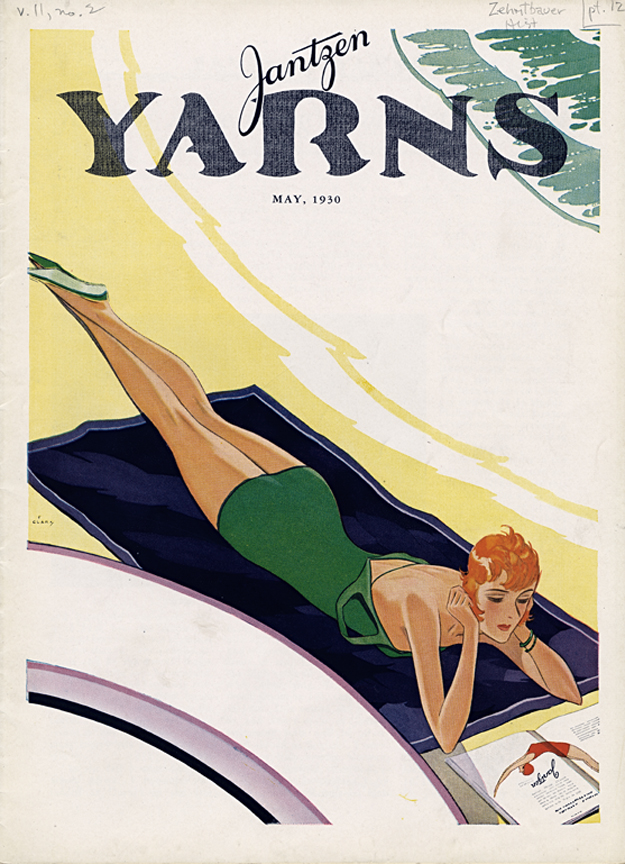Jantzen Yarns is a serial of the Jantzen Knitting Mills published by and for workers at the Portland, Oregon, textile manufacturer. This cover from the May 1930 issue features artwork typical of the company's advertising during the 1930s. Jantzen was the world's leading manufacturer of swimming suits in 1930. After creating an innovative stitch for bathing suit material in 1913, the business began mass producing economical bathing suits for men and women and enjoyed astronomical growth between 1917 and 1930.
Jantzen's new stitch produced a garment much more conducive to swimming than bathing suit fashion at the turn of the century dictated. This was especially true for women, whose bulky bathing attire was a real obstacle to learning how to swim. During the first two decades of the century, female athletes such as Australian swimmer Annette Kellerman first publicly donned functional swimming garments and, with some struggles over censorship, paved the way for the practical suit. With Jantzen's rise to popularity, the company played a significant role in transforming attire designed for swimming into something fashionable.
Effective advertising was one of Jantzen's keys to success. The company first advertised in Portland newspapers in 1916. In the years that followed, the knitting company extended distribution and advertising to Washington and California, leading to a nationwide campaign in 1920. One advertising technique the company employed was to maintain an association with athleticism. In 1921, company officials decided to refer to their products strictly as "swimming suits" rather than "bathing suits." As one of the first companies to do so, Jantzen helped the term catch on as an industry standard. Jantzen nurtured the rising popularity and acceptance of the sport among women by offering free swimming seminars as a part of a nationwide "Learn-to-Swim-Week" campaign in 1926. Advertising artists created figures of female swimmers in various athletic poses.
But Jantzen suits were not only designed for athletes, as the front cover of this publication suggests. To buy a Jantzen suit was to make a fashion statement. The company helped foster a fashion-conscious public with department store features such as color wheels designed to help individuals "scientifically" select flattering swimming suit hues. Jantzen also provided retailers with "Size-O-Weight" scales, contraptions that registered a customer's Jantzen suit size, thereby eliminating the need to discuss weight with salespeople.
Further reading:
Vreeland, Carl. From Shearing Shed to Swimming Suit: The Story of an Oregon Enterprise. Portland: Jantzen Knitting Mills, 1936.
Lencek, Lena and Gideon Bosker. Making Waves: Swimsuits and the Undressing of America. San Francisco: Chronical Books, 1989.
Written by Sara Paulson, © Oregon Historical Society, 2007.
